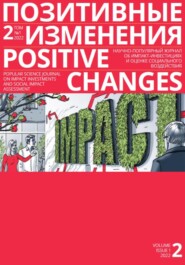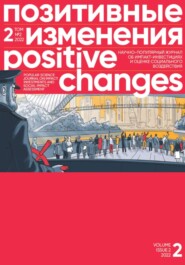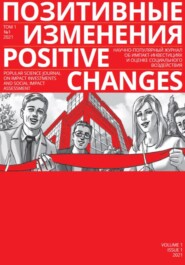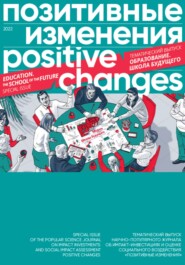По всем вопросам обращайтесь на: info@litportal.ru
(©) 2003-2025.
✖
Позитивные изменения. Города будущего. Тематический выпуск, 2022 / Positive changes. The cities of the future. Special issue, 2022
Настройки чтения
Размер шрифта
Высота строк
Поля
• возможность проводить обсуждения с достаточной представленностью граждан;
• доступность прямых каналов коммуникации между органами местного самоуправления и жителями.
Как отмечают авторы обзора, суть практик партисипаторного бюджетирования «состоит в развитии эффективной системы взаимодействия органов местного самоуправления и общества через активизацию прямого участия граждан в планировании местного развития, в том числе в определении приоритетов расходования средств местного бюджета и в поддержке инициатив граждан в решении вопросов местного значения».
В России инициативное бюджетирование реализуется в основном по модели Программы поддержки местных инициатив (ППМИ). В рамках этой модели жители вовлекаются в определение приоритетных направлений расходования бюджетных средств, могут софинансировать важные для себя проекты, а также контролировать ход их выполнения. Однако, эта модель является региональной, а не локальной.
Одним из примеров реализации практик партисипаторного бюджетирования в России на локальном уровне является опыт городского округа Лабытнанги (ЯНАО). В основном это проекты развития городской среды и создания инфраструктуры для людей с особыми потребностями. Интересно, что особенностью этого проекта стало требование к инициаторам в виде обязательного софинансирования деятельности в рамках бюджета в размере не менее 3 % от выделяемых средств. Проекты проходят экспертизу в Проектном офисе, который включает экспертов и волонтеров, а потом выносятся на голосование жителей. Также Проектный офис занимается планированием деятельности, информированием и обучением, а также участвует в подготовке голосования по проектам.
Таким образом, культура соучастия превращает человека из потребителя в соавтора продукта, субъекта городского развития. Наличие таких ценностных установок способствует реализации инноваций снизу-вверх, а также позволяет стимулировать развитие локального сообщества, создавая ткань городов будущего и обеспечивающего реализацию всех выше перечисленных элементов существующих концепций городов будущего.
СПИСОК ИСТОЧНИКОВ
1. Latham, A., & Layton, J. (2019). Social infrastructure and the public life of cities: Studying urban sociality and public spaces. Geography Compass, 13(7), e12444. https://doi.org/10.1111/gec3.12444.
2. Moreno, C., Allam, Z., Chabaud, D., Gall, C., & Pratlong, F. (2021). Introducing the "15-Minute City": Sustainability, resilience and place identity in future post-pandemic cities. Smart Cities. 4(1), 93-111. https://doi.org/10.3390/smartcities4010006.
3. Pincus, S. (1995). «Coffee Politicians Does Create»: Coffeehouses and Restoration Political Culture. The Journal of Modern History, 67(4), 807–834. https://doi. org/10.1086/245229.
4. Tweed, C., & Sutherland, M. (2007). Built cultural heritage and sustainable urban development. Landscape and urban planning, 83(1), 62–69. https://doi.org/10.1016/j. landurbplan.2007.05.008.
5. Верещагина, Е. И. (2021). Соучаствующее проектирование: особенности подхода в России. Городские исследования и практики, 6(2), 7-25. https://doi. org/10.17323/usp6220217-25.
6. Малышев, А. А., Коробкова, Н. А., Солодков, Н. Н. (2021). Перспективы внедрение концепции умных городов как основа устойчивого развития. Московский экономический журнал, (12), 798–809. https://doi. org/10.24412/2413-046X-2021-10777.
7. Николаева, Ж. В. (2021). Черта идентичности: становление города. Журнал фронтирных исследований, 6(1 (21)), 144–159. https://doi.org/10.46539/jfs. v6i1.258.
8. Ольденбург, Р. (2018). Третье место: кафе, кофейни, книжные магазины, бары, салоны красоты и другие места «тусовок» как фундамент сообщества. Новое Литературное Обозрение.
9. Перезолова, А. С. (2018). Практики партисипативного управления в публичной политике. Вестник Российского университета дружбы народов. Серия: Политология, 20(1), 122–130. https://doi.org/10.22363/2313-1438-2018-20-1-122-130.
10. Хачатрян, Г. Н., Гаврилова, Н. В., Шульга, И. Е. & Сухова, А. С. (2020). Практики партисипаторного бюджетирования в малых городах. Москва: Алекс.
The "Foundation" of the City of the Future: Key Trends and Design Approaches
The concept of the City of the Future is the concept of integrated urban development, which implements a systematic approach to sustainable development and ahead-of-the-market conceptual and planning solutions to create a comfortable, safe and environmentally friendly urban and social environment. Experts from the Positive Changes Factory offer their vision of what the approaches to developing concepts for the City of the Future might be.
Vladimir Vainer
Director, Positive Changes Factory
Ivan Smekalin
Analyst, Positive Changes Factory, MA in Sociology student (EHESS, Paris)
The topic of the "City of the Future" was actively developed by famous architects throughout the twentieth century in many countries. Cities of the future appeared in the descriptions of numerous literary works and on movie screens. The topic got a new lease of life in the twenty-first century with the emergence of new technological and social solutions. Today, the term "city of the future" has a dual meaning and application: it is used to refer both to real projects using actual urban planning and technological solutions, and to conceptual projects of an exploratory and research nature.
Conceptual projects are interesting because they do not operate with a set of tools and techniques that can be implemented today, but provide an opportunity to look into the future, which so far is a likely prospect, depending on the development scenario the humanity chooses in the next decade.
ARCHITECTURE AND URBAN PLANNING OF THE FUTURE: KEY TRENDS
BIOPHILIA
British architect Norman Foster, winner of the Pritzker Prize (considered the equivalent of the Nobel Prize in architecture) is most commonly called as the architect of the future. It was Foster who in the 1970s modeled an energy-efficient hi-tech building made of glass and steel. However, today his ideas of architecture are based on the concept of "biophilia" – the natural proximity of people to nature and natural materials. The architecture becomes focused on the principles of a focus on health, a connection to well-being and a holistic perception of the building. The architect’s skyscrapers can be perceived as vertical cities, where floors act as streets with full social infrastructure, which is located not just on the lower floors.
NON-EXTRACTIVE ARCHITECTURE
The biophilia element aligns well with the notion of "non-extractive architecture," a new type of architecture that does not deplete the Earth’s resources. Its concept was presented by Joseph Grima, co-founder of the Italian research studio Space Caviar, at Dezeen 15 festival The key idea is that architecture should not create external negative effects for third parties. This applies not only to carbon emissions and energy consumption issues, but also to ecosystem sustainability, community preservation, and avoidance of labor exploitation. The author of the concept says that the construction industry generates 40 % of carbon emissions, and Western companies claiming sustainable development actually outsource the negative effects – that is, they still cut down forests, but not in their home countries, but in the countries of the "Global South." Timber transportation further adds to environmental damage.
"YES IS MORE".
Speaking of innovations in urban planning, it is impossible not to mention Bjarke Ingels of Denmark, who is also often called the architect of the future. The principles of Ingels’ projects are: to build for eternity, not for "disposable" architecture; a large landscaping area; multifunctional nature (from social infrastructure in residential complexes to a sports and entertainment complex on the roof of a garbage incineration plant). Ingels himself says that he designs a living environment with the psychological needs of the individual in mind and with the creation of benefits for society. In his manifesto[23 - M?ller, A. Yes Is More: The BIG Philosophy. Retrieved from: https://www.archdaily. com/366660/yes-is-more-the-big-philosophy. 06 May 2013. ArchDaily. (accessed 06.10.2022).], presented in the form of a comic book, the architect cites the evolutionary formula "survival of the fittest" and proposes an architecture that can help humanity adapt to the changes of the future. The title of the manifesto is "Yes Is More", meaning that by saying yes to society, one is saying yes to oneself and the future.
Another interesting element of Bjarke Ingels’ philosophy, which can be applied to all potential projects of the city of the future, is that the city is not finished content; it is a form, which can be adapted to conditions that are unknown in advance, and take into account the public good.
THE 15-MINUTE CITY
The concept of the 15-Minute City is that all the places a resident needs are within a 15-minute walk or ride by last-mile transport[24 - Last-mile is a term used to describe the last leg of a journey: when a passenger takes the bus home from work, the last mile is the journey from the bus stop to the apartment.] (bicycle, scooter, electric scooter, etc.). Places for living, study, work, recreation, sports and health facilities are not divided into "bedroom" communities and business districts, but are mixed within the framework of a single district, thus avoiding daily commute.
The concept emerged during the development of the New York City master plan in the 1920s and had the following characteristics:
• only local roads can be located within a neighborhood, and all highways must be placed outside the neighborhood;
• the school must accommodate all children in the neighborhood and be accessible without crossing major roads;
• each neighborhood must have its own park;
• stores should not be located in the center, but on the perimeter of the neighborhood.
In 2021, this model was revived during the discussion of the master plan of Paris with the social researchers. The authors claim that it is designed to increase proximity and social interaction, as well as to boost solidarity and good neighborly relations (Moreno et al., 2021).
This was also the logic behind the "Cities of the Future" concept proposed by the Gladway Foundation for the Development of Media Projects and Social Programs. In 2016–2020, as part of the Citi Foundation’s Sustainable Cities Program, the Gladway Foundation implemented the idea of neighborhood centers within a walking distance in Moscow. According to the authors of the concept, neighborhood centers are the foundation of cities of the future, creating a "social fabric" for economic and territorial development. "Without neighborhood centers (as a comprehensive "city-oriented" public space – editor’s note), there is no future for the city," the authors stressed at the VI conference "Factory of Spaces. Time," held in October 2022 in Moscow.
The «15-minute city» can be the basis for the creation of the City of the Future.
Interestingly, "My Neighborhood" city program, currently implemented in Moscow, is also based on the concept of a 15-minute city. This was announced by Mayor Sergey Sobyanin on the sidelines of SPIEF-2021, in an interview with "Russia 24" TV channel.
The size of the "15 Minute District" is an area of 3x3 kilometers (900 hectares). "This area is small enough for a single large developer to complete. But construction companies usually specialize in one single thing (housing, offices, etc.), while here we have to build everything at once," says co-founder and chief architect of UNK project design bureau, member of the Union of Moscow Architects Yuli Borisov, as quoted by SberPro Media[25 - SberPro Media. (2021). Making it in 15 minutes: how the new concept of urban planning is gaining popularity in Russia. Retrieved from: https://sber. pro/publication/uspet-za-15-minut-kak-novaia-kontseptsiia-gradostroeniia-nabiraet-populiarnost-v-rossii. 12.11.2021. (accessed 22.09.2022).].
Summing up this part of the review, let us emphasize: the 15-minute city as a concept can be the basis for the creation of the City of the Future (by even a single developer). In addition, this concept is the closest to the implementation of pilot projects. The principles mentioned above must also be respected: the natural proximity of people to nature (biophilia), non-extractive architecture, building for eternity, the city as a form that can be adapted to conditions that are unknown in advance, and take into account the public good.
CONTEMPORARY PRINCIPLES OF SUSTAINABLE AND INCLUSIVE URBAN DESIGN
THE SAN MARINO DECLARATION
Environment and sustainable development are becoming the key topics affecting the full range of design solutions; they are present in brand new concepts of the city of the future, as well as in those that follow up on the development of well-known approaches.
The model of an environmentally, socially and economically sustainable city most often acts as the foundation for designing the cities of the future (Malyshev, Korobkova & Solodkov, 2021). This model is directly related to the UN Sustainable Development Goals. The bare-bones agenda for a sustainable city is the "smart city" model: efficient use of resources through the introduction of technological systems, a better quality of life through improved services, transport and information accessibility. It is worth noting that this model generally does not take into account the social component of the city, while focusing mainly on the infrastructure and technological aspects.









